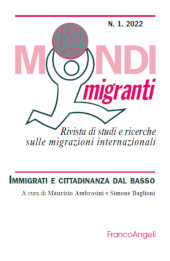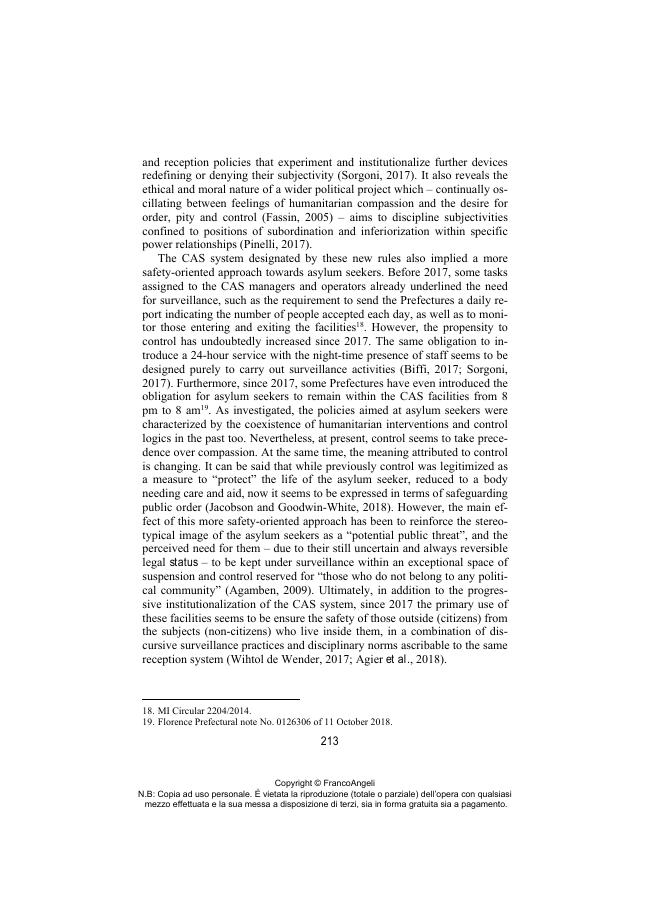The evolution of the Italian reception system for asylum seekers into a "non-place" for "non-subjects"
201-225 p.
The article provides a critical analysis of the evolution of the Italian migrant reception system following the 2014 "refugee crisis". The aim is to demonstrate how the touted goal of discouraging socalled "bogus asylum seekers" or "fraudulent economic migrants" has been used to institutionalize the Emergency Reception Centres (CAS) as the ordinary place to host asylum seekers, while the ordinary reception system has been greatly weakened. Furthermore, this process to institutionalize the CASs has been accompanied by the progressive distancing of the regulations for these facilities from the decentralized and dispersed model sought in the ordinary reception system. The reflection is based on a comparative analysis of the tendering procedures to allocate the emergency reception services drawn up by the Prefectures of Florence, Siena and Arezzo between 2015 and 2019. This analysis is divided into three phases.
The first refers to the years 20152017, when the CAS system was mainly regulated by ministerial circulars. The second phase analyses the period following the issuing of the Ministerial Decree of 7 March 2017 which introduced specific and more detailed regulations for these facilities for the first time. The final phase concentrates on the entry into force of Law no. 132/2018, which transformed the SPRAR system into SIPROIMI, and the Ministerial Decree of 20 November 2018 which modified the CAS system again. [Publisher's text].
L'articolo fornisce un'analisi critica dell'evoluzione del sistema italiano di accoglienza a seguito della 'crisi dei rifugiati' del 2014. Lo scopo è mostrare come l'obiettivo propagandato di scoraggiare i cosiddetti 'finti rifugiati' o 'migranti economici fraudolenti' sia stato usato per istituzionalizzare il Centro di Accoglienza straordinario (CAS) come luogo ordinario per ospitare il richiedente asilo, mentre il sistema di accoglienza ordinario è stato fortemente depotenziato. Inoltre, tale processo di istituzionalizzazione del CAS è accompagnato da un progressivo distanziamento della regolamentazione di queste strutture dal modello decentralizzato e diffuso ricercato nel sistema di accoglienza ordinario. La riflessione si fonda su una analisi comparativa dei Bandi di gara per l'affidamento dei servizi di accoglienza straordinaria predisposti, tra il 2015 e il 2019, dalle Prefetture di Firenze, Siena e Arezzo. Tale analisi è suddivisa in tre fasi.
La prima fase si riferisce agli anni 20152017, periodo in cui il sistema CAS è regolato principalmente attraverso circolari ministeriali. La seconda fase analizza il periodo successivo all'emanazione del Decreto Ministeriale del 7 marzo 2017 che, per la prima volta, introduce una disciplina specifica e più dettagliata per queste strutture. L'ultima fase si concentra sull'entrata in vigore della legge n. 132/2018, che trasforma lo SPRAR in SIPROIMI, e del decreto ministeriale del 20 novembre 2018 che modifica nuovamente il sistema CAS. [Testo dell'editore].
Ist Teil von
Mondi migranti : 1, 2022-
Artikel aus derselben Ausgabe (einzeln erhältlich)
-
Informationen
ISSN: 1972-4896
KEYWORDS
- sistema di accoglienza italiano, richiedente asilo, identità burocratica, segregazione, dispositivi di controllo, approccio securitario
- Italian Reception System, asylum seeker, bureaucratic identity, segregation, control devices, safetyoriented approach



